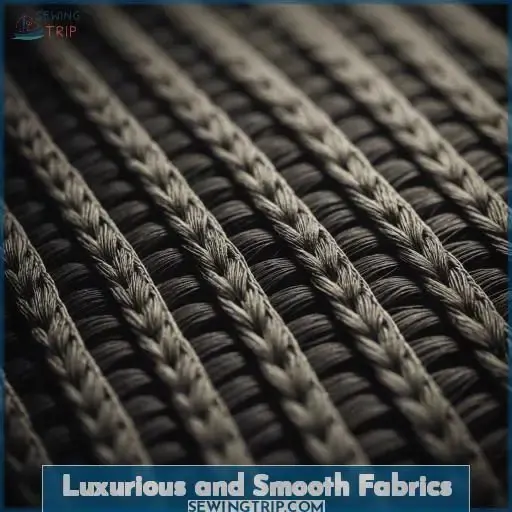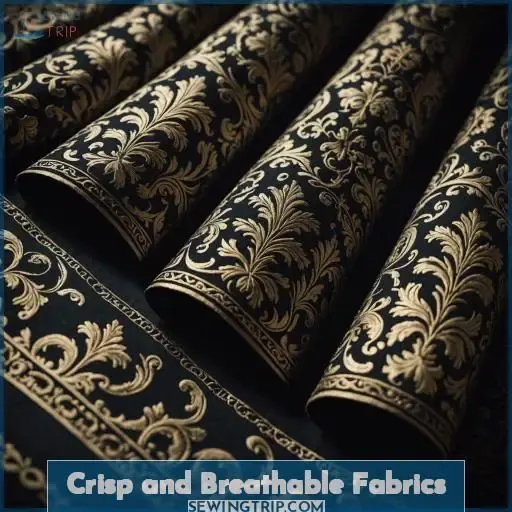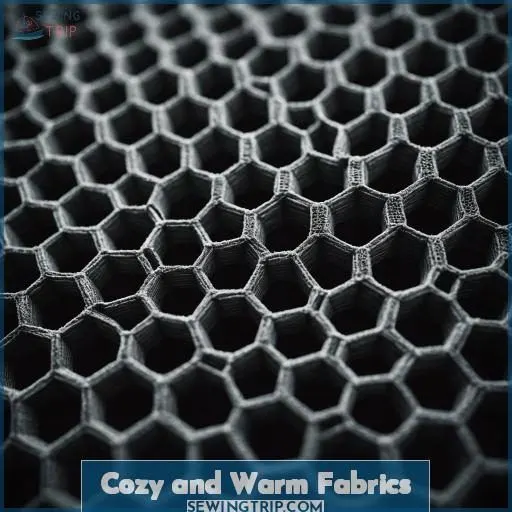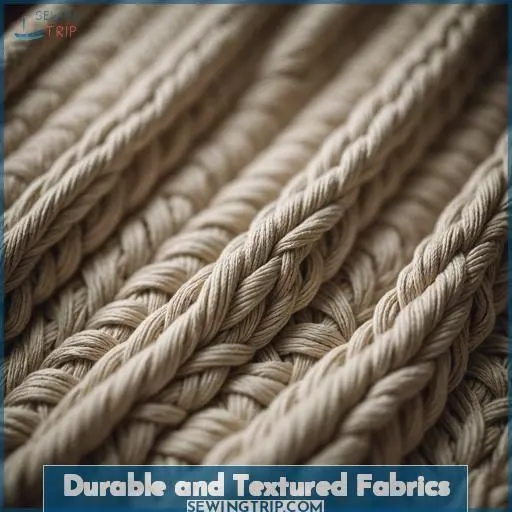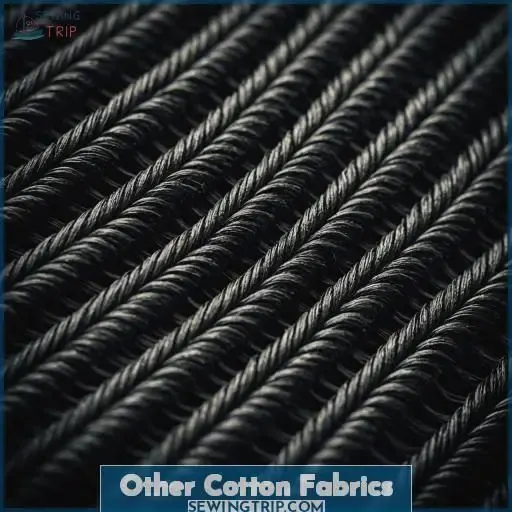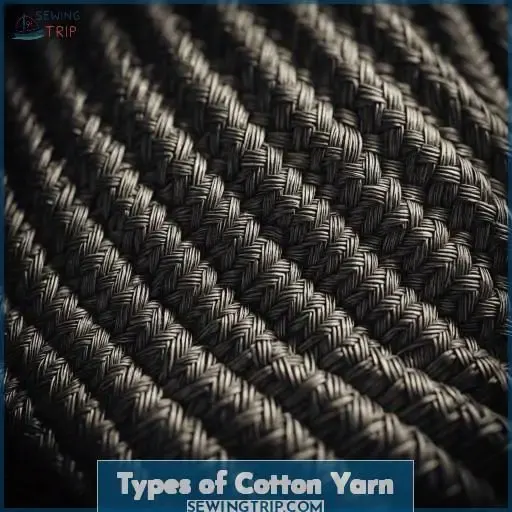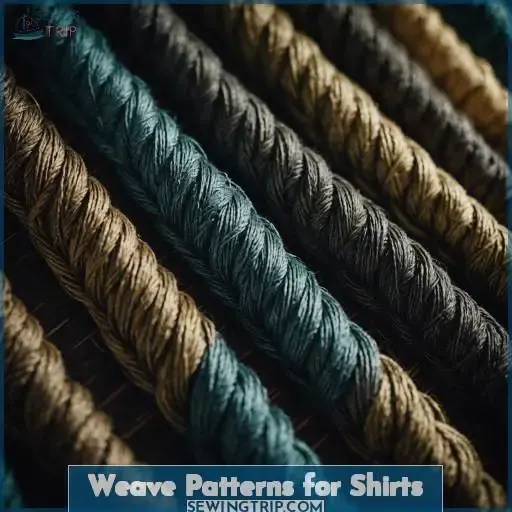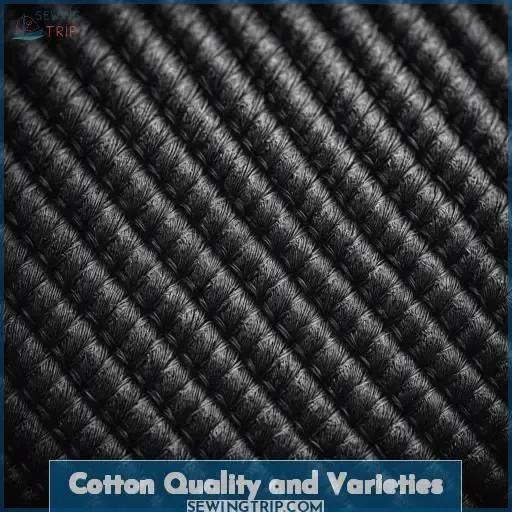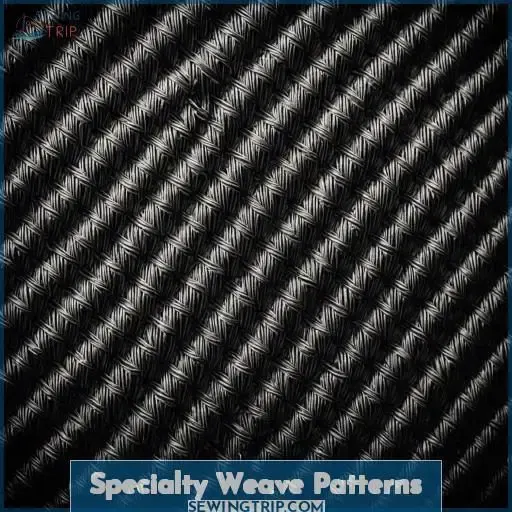This site is supported by our readers. We may earn a commission, at no cost to you, if you purchase through links.
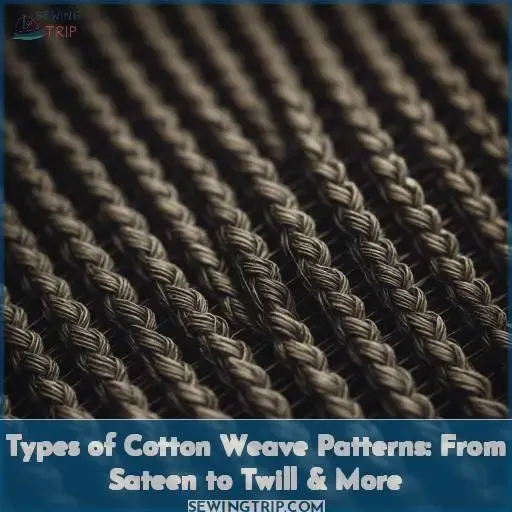
Flannel’s cozy warmth and plush nap offer comfort, while twill‘s distinctive diagonal rib pattern provides both durability and the ability to hide stains.
Beyond these classic weaves, the realm of cotton fabrics encompasses everything from the structured texture of canvas to the casual charm of gingham.
Table Of Contents
- Key Takeaways
- Weaving Basics: Warp & Weft
- Luxurious and Smooth Fabrics
- Crisp and Breathable Fabrics
- Cozy and Warm Fabrics
- Durable and Textured Fabrics
- Other Cotton Fabrics
- Types of Cotton Yarn
- Weave Patterns for Shirts
- Cotton Quality and Varieties
- Specialty Weave Patterns
- Frequently Asked Questions (FAQs)
- Conclusion
Key Takeaways
- Cotton weave patterns range from the luxurious sheen of sateen to the crisp breathability of percale.
- Warp and weft threads are the foundation of any woven fabric, and their arrangement gives the textile its unique characteristics.
- The warp threads run lengthwise, while the weft threads run across the width of the fabric.
- Handlooms were the original weaver’s tool, with the shuttle being threaded through alternately raised warps by hand.
Weaving Basics: Warp & Weft
Understanding the basics of warp and weft is essential for anyone interested in the art of weaving or the textiles industry. Warp and weft threads are the foundation of any woven fabric, and their arrangement is what gives the textile its unique characteristics. The warp threads are the ones that run lengthwise, while the weft threads run across the width of the fabric. Together, they create a strong and stable structure for the textile.
Warp threads are held stationary in tension on a loom, while the weft is drawn through and inserted over and under the warp thread. In the terminology of weaving, each warp thread is called a warp end, and a pick is a single weft thread that crosses the warp thread. The warp is the set of yarns or other things stretched in place on a loom before the weft is introduced during the weaving process. It’s regarded as the longitudinal set in a finished fabric with two or more sets of elements. The term is also used for a set of yarns established before the interworking of weft yarns by some other method, such as finger manipulation, yielding wrapped or twined structures.
The warp must be strong to be held under high tension during the weaving process, unlike the weft which carries almost no tension. This requires the yarn used for warp ends or individual warp threads to be made of spun and plied fibre. Traditionally, wool, linen, alpaca, and silk were used, but improvements in spinning technology during the Industrial Revolution created cotton yarn of sufficient strength to be used in mechanized weaving. Later, artificial or man-made fibres such as nylon or rayon were employed.
While most weaving is weft-faced, warp-faced textiles are created using densely arranged warp threads. In these, the design is in the warp, requiring all colors to be decided upon and placed during the first part of the weaving process, which can’t be changed. Such limitations of color placement create weavings defined by length-wise stripes and vertical designs. Many South American cultures, including the ancient Incas and Aymaras, employed backstrap weaving, which uses the weight of the weaver’s body to control the tension of the loom. Because the weft doesn’t have to be stretched on a loom the way the warp is, it can generally be less strong and is usually made of spun fibre, originally wool, flax and cotton, today often of synthetic fibre such as nylon or rayon. The weft is threaded through the warp using a shuttle, air jets or rapier grippers. Handlooms were the original weaver’s tool, with the shuttle being threaded through alternately raised warps by hand.
Luxurious and Smooth Fabrics
Looking to elevate your bedding experience? Sateen and satin-like weaves are the epitome of luxury, boasting a subtle sheen and a smooth, wrinkle-resistant feel that’ll have you sinking into comfort.
Sateen
Sateen is a luxurious and smooth fabric that’s been around for ages. It’s created by using a satin-like weave, which gives it a subtle sheen and makes it feel silky to the touch. You’ve probably seen sateen in curtains, sheets, and bedding. Here are three reasons why you’ll love it:
- Wrinkle-resistant: Sateen is less prone to wrinkles compared to other cotton fabrics, making it perfect for those who want a hassle-free laundry experience.
- Soft and breathable: The fabric is soft and breathable, ensuring you stay cool and comfortable even during hot summer nights.
- Versatile: Sateen isn’t just for bedding. It’s also used in clothing, particularly for dress shirts, where it provides a crisp, smooth look.
Satin-like Weave
Satin-like weave fabrics are known for their luxurious and smooth finish, often associated with a subtle sheen and wrinkle-resistant properties. These fabrics are typically made using a satin weave technique, which involves lengthy floating yarns on the fabric’s surface, resulting in a glossy top surface and a dull texture at the back. Some popular satin-like weave fabrics include:
- Sateen: A type of satin made from short-staple yarns, often cotton, that mimics the appearance and feel of satin. It’s more durable and machine-washable than traditional satin, making it suitable for a variety of applications.
- Jacquard weave: This weaving technique allows for the creation of intricate patterns and designs on the fabric surface, often found in high-end clothing and home decor items.
- Dobby weave: A type of weaving that involves raising and lowering the weft threads to create a raised pattern on the fabric surface, often used in casual wear and home textiles.
- Leno weave: A weaving technique that involves a complex interlacing of warp and weft threads, resulting in a firm, smooth fabric with a subtle sheen, often used in upholstery and curtains.
Satin-like weave fabrics are often associated with luxury and elegance, making them popular choices for formal wear, high-end home decor, and special occasion garments. Their smooth texture and subtle sheen make them a versatile choice for a wide range of applications.
Crisp and Breathable Fabrics
Looking for a crisp, breathable fabric? Consider the classic percale weave – it’s ultra-breathable with a casual, no-sheen finish, though it may be prone to wrinkles. On the other hand, the percale’s tightly woven structure makes it a durable and practical choice for everyday use.
Percale
Percale is a crisp and breathable fabric that’s perfect for those hot summer nights. With a plain weave, it’s created by interlacing warp and weft threads over and under each other. Here are four things to know about percale:
- Thread Count: Higher thread count means more threads per square inch, resulting in a smoother finish and better durability.
- Bedding Sets: Percale is popular for bedding sets due to its breathability and ability to keep cool.
- Sheets and Pillowcases: Percale sheets are known for their crisp feel and ability to maintain their shape. Pillowcases are often made from percale fabric for the same reasons.
- Alternatives: If you’re not a fan of the crisp feel, you might prefer sateen or satin-like weaves, which have a softer touch.
- Fabric Types: Percale is a type of woven fabric, making it suitable for a variety of uses, including shirts.
Ultra-breathable Weave
Imagine slipping into bed on a balmy summer night, your skin embraced by the cool, crisp caress of percale sheets. This exceptionally breathable weave is a sanctuary for those yearning for a rejuvenating sleep experience. With a high thread count, percale boasts a delicate texture that’s both moisture-wicking and airy, ensuring your comfort and dryness. Its opacity doesn’t impede its graceful drape, granting your bedding a relaxed yet sophisticated appearance. Consider percale the ethereal essence in fabric form, akin to the delicate translucency of gauze or voile, yet retaining the orderliness of a manicured lawn.
| Quality | Description |
|---|---|
| Thread Count | High, for a finer texture |
| Breathability | Exceptional, akin to gauze or voile |
| Moisture | Wicking, keeps you dry and comfortable |
| Drape | Elegant, with a casual, crisp finish |
Cozy and Warm Fabrics
Searching for warmth and comfort in your next textile project? Consider flannel – this fabric’s brushed finish creates a plush, velvety texture that’ll keep you cozy all season long. Whether you’re making comfortable pajamas or a durable winter shirt, flannel’s got the comfort and coziness you’re after.
Flannel
Flannel is a type of cotton fabric known for its cozy warmth and plush texture. It’s often used for making flannel sheets, pajamas, shirts, blankets, and robes. Flannel is created by brushing the fabric to raise the nap, giving it a soft, fuzzy surface. Here are four key points about flannel:
- Soft and Comfortable: The brushed surface makes flannel incredibly soft and warm, perfect for snuggling up in bed or wearing as loungewear.
- Versatile: Flannel isn’t just for pajamas or bedding; it’s also used in shirts and robes, making it a versatile choice for various clothing items.
- Durable: Despite its softness, flannel is quite durable and can withstand repeated washings without losing its quality.
- Eco-Friendly: Many flannel products are made from recycled materials, making them an eco-friendly choice for those who care about sustainability.
Brushed Technique
Brushed cotton is a technique that softens the fabric’s surface, often employed to create cozy and warm fabrics. This process entails brushing the fabric to raise its fibers, producing a soft, plush texture.
The brushed technique is commonly applied to flannel, but it can also be used on other fabrics such as broadcloth, chintz, or cotton poplin. The raised fibers not only contribute to the fabric’s warm and cozy feel but also aid in wrinkle prevention.
Dobby and jacquard looms are frequently used to create these brushed fabrics, enhancing their textured appearance.
Durable and Textured Fabrics
With regard to durable and textured fabrics, twill distinguishes itself with its characteristic diagonal weave. This robust textile features a gentle, thick feel and a textured surface that proficiently conceals dirt and stains, rendering it a flexible option for everyday shirts and workwear.
Twill
Twill weave, a type of cotton fabric, is known for its distinctive diagonal rib pattern and durability. This weave is created by an offset in the warp threads, resulting in a fabric that’s both strong and versatile. Twill weave is popular for its ability to hide stains well, making it suitable for a wide range of clothing and upholstery applications.
Twill fabrics are constructed with two sides that aren’t the same. The front, known as the technical face, is typically more durable and appealing, often used as the fashion side of the fabric. The back, known as the technical back, has filling floats that correspond to the warp floats on the technical face. Twill fabrics are woven with no up and down directions, and they’re rarely used in sheer fabrics. Printed twills, where a design is printed on the cloth, are less common than printed plain weaves due to the irregular surface of twills.
Twill weave is available in various types, such as serge, herringbone, houndstooth, and denim. It’s used in a wide variety of garments and products, including pants, jackets, backpacks, curtains, upholstery, and bedding. To care for twill fabric, it should be machine washed in cold water, air-dried, and ironed at low temperatures to avoid damaging the fabric. Avoid harsh chemicals, such as bleach and abrasive cleaning products, as they can damage the material.
Twill fabric is an environmentally-friendly choice due to its durability and strength, which means it lasts longer and reduces the need for frequent replacements. To further minimize the environmental impact, recycled or upcycled fabrics are the ideal choice for twill products.
Distinctive Diagonal Weave
You’ve already learned about twill, a fabric with a distinctive diagonal weave. This weave pattern adds texture variation, making it ideal for creating durable and textured garments.
The diagonal weave also offers dirt and stain resistance, enhancing the durability of twill fabrics.
Whether you’re choosing sateen or twill, the diagonal weave is a key factor in the fabric’s overall quality and performance.
Other Cotton Fabrics
Beyond the classic weaves, cotton fabrics offer a diverse array of textures and visual patterns. From the rugged durability of canvas to the subtle elegance of chambray, corduroy’s cozy cords, gingham’s iconic checks, and the sheer lightness of muslin, the realm of cotton provides endless possibilities for the discerning textile enthusiast.
Canvas
After exploring the rugged charm of twill, let’s delve into canvas, the heavyweight champion of the cotton world. Its cross weaving process gives it unparalleled durability, making it ideal for:
- Canvas painting
- Canvas bags
- Canvas shoes
- Canvas furniture
- Canvas prints
Chambray
Chambray is a lightweight, denim-like fabric that offers a unique blend of comfort and style. It’s often used for chambray shirts and curtains, and comes in a variety of colors.
Chambray is similar to denim but has a smoother texture and is less heavy. It’s also often compared to chambric, another lightweight fabric.
Chambray is a versatile cotton fabric with a distinctive weave pattern.
Corduroy
Delve into the realm of corduroy, a versatile textile adorned with distinctive textures and motifs. From its elevated cords to its diverse array of hues and styles, corduroy holds a prominent place in the lexicon of fabric aficionados. Explore its annals, weaving methods, and its comparative standing alongside other fabrics such as basketweave, cretonne, and indienne.
Gingham
Gingham, a timeless fabric, is a type of cotton apparel fabric known for its checkered pattern and diverse color palette. Its history dates back to the 18th century, making it a fabric of our lives.
Gingham patterns range from subtle to bold, suitable for various gingham clothing items and home decor.
Understanding the types of weave patterns, such as basketweave or broadcloth/poplin, can enhance your appreciation for this versatile fabric.
Muslin
Muslin is a versatile and lightweight fabric with a plain weave structure. It’s made from 100% natural cotton and is known for its softness, breathability, and lightness. Muslin is often used in a variety of applications, including clothing, curtains, upholstery, and home decor. There are several types of muslin, each with its own unique characteristics:
- Lightweight Muslin: Suitable for garments like blouses, dresses, and lightweight summer clothing.
- Medium-weight Muslin: Versatile and suitable for various projects such as tops, skirts, and linings.
- Heavy-weight Muslin: Offers more structure and is great for creating sturdy prototypes, corsets, and structured garments.
Muslin is also available in different weights, which can affect its ideal uses. Lightweight muslin is perfect for delicate drapes, lightweight garments, and breathable summer clothing. Medium-weight muslin provides versatility, making it suitable for various projects. Heavy-weight muslin offers more structure and is great for creating sturdy prototypes.
Muslin is often used in sewing and crafting projects due to its softness and ease of use. It can be machine washed in lukewarm or cold water with mild detergents. However, it’s important to pre-treat heavily stained muslin and hand wash delicate or embellished fabrics. Muslin should be air dried to avoid shrinkage and stored clean and dry to prevent mold growth.
Types of Cotton Yarn
Choosing between pearl and unmercerized cotton comes down to your specific needs. Pearl cotton has a subtle sheen and absorbs dyes better, while unmercerized cotton is more matte in texture and better at water absorption – making it a great choice for towels.
Pearl Vs. Unmercerized Cotton
In selecting the appropriate cotton yarn for your project, discerning the distinctions between pearl and unmercerized cotton can prove pivotal. Here’s a brief comparison:
| Pearl Cotton | Unmercerized Cotton |
|---|---|
| Absorbs dyes better | Duller in color |
| Has a sheen | Absorbs water better |
| Absorbs water better | Has a more matte texture |
| Thicker (4,200 yd/lb) | Thinner (3,360 yd/lb) |
| Available from most weaving retailers | Available from many weaving retailers |
Pearl cotton is frequently employed for placemats, runners, and towels, while its unmercerized counterpart finds favor in towels owing to its enhanced absorbency. Both varieties can be utilized for dress shirts, with pearl cotton imparting a sheen and pima cotton providing premium cotton goods for such garments. Ultimately, the choice between pearl and unmercerized cotton rests upon your preferred sheen, absorbency, and texture.
Uses of Pearl and Unmercerized Cotton
Explore the realm of cotton yarns and discover the distinctions between pearl and unmercerized cotton.
Pearl cotton boasts a superior luster and absorbs dyes more effectively, making it the preferred choice for tailoring custom dress shirts, royal oxford, or pinpoint oxford shirts.
Conversely, unmercerized cotton exhibits a more muted texture and enhanced absorption, rendering it suitable for casual shirts or towels.
Both varieties are available in diverse sizes and hues, accommodating varied requirements.
Weave Patterns for Shirts
In terms of shirt weave patterns, there’s a wide range of options available. Basketweave, broadcloth/poplin, oxford, and royal oxford are all well-known choices, each providing its own distinctive texture, breathability, and level of formality.
Basketweave
After delving into the realm of cotton yarns, let’s unravel the basketweave. This texture isn’t solely reserved for baskets; its variations infuse vitality into upholstery and curtains, enhancing spaces. It’s the multi-faceted fabric, versatile in applications yet perpetually stylish.
Broadcloth/Poplin
Broadcloth, also known as poplin, is a versatile and popular type of dress shirt fabric. It’s characterized by its lightweight, smooth, and flat appearance, with no pattern in the weave of the threads.
Broadcloth is similar to pinpoint fabric but has less texture, making it slightly more transparent and not as shiny as pinpoint fabric.
This weave is suitable for a variety of dress shirt styles and occasions, from formal to casual.
Oxford
After diving into the sleek world of Broadcloth/Poplin, let’s shift gears to the robust oxford weave. Known for its oxford texture, this weave brings oxford shirting to life, marrying oxford durability with oxford versatility. It’s the Swiss Army knife of fabrics, ready for any wardrobe challenge.
Royal Oxford
Explore the elegance of a Royal Oxford shirt, a dressy and refined choice for your wardrobe. This mid-weight fabric boasts a distinctive basket weave texture, giving it a silky finish that’s comfortable to wear. The wrinkle-resistant finish ensures you remain crease-free all day, making it a versatile piece suitable for year-round wear.
Cotton Quality and Varieties
Beyond the standard cotton varieties, you’ll find specialty cottons like Liberty cotton, known for its intricate prints, and Pima cotton, prized for its exceptional softness and durability. Sashiko, the Japanese embroidery technique, also calls for a specific type of cotton thread that’s essential for achieving its characteristic look.
Liberty Cotton
Unveiling the realm of Liberty Cotton, a fabric renowned for its versatility and exquisite prints. This textile is ideal for diverse applications, from adorning homes to crafting attire. Behold four compelling reasons why Liberty Cotton is an indispensable choice:
- Liberty Prints: These distinctive and enduring designs are a cornerstone of the brand’s identity.
- Floral Delicacies: The intricate and elaborate floral patterns imbue any creation with an air of sophistication.
- Exceptional Thread Density: The high thread count guarantees longevity and a velvety finish.
- Conscientious Production: Liberty Cotton adheres to ethical production practices, rendering it a responsible selection for discerning consumers.
Cotton for Sashiko
If you’re a fan of sashiko, you’ll want to know about the perfect cotton for this traditional Japanese art. Look for high-quality cotton for quilting, with a thread count suitable for sashiko.
Indigo is a popular color for sashiko, but you can use any color that speaks to you.
For embroidery, choose cotton that’s soft yet sturdy, allowing your needle to glide smoothly.
Pima Cotton
Pima cotton, also known as extra-long staple cotton, is a high-quality cotton variety renowned for its softness and durability. It’s cultivated in the arid regions of the world, such as Peru and Arizona, where the plants receive abundant sunlight and water.
Pima cotton fibers are longer and more uniform than other cotton varieties, resulting in a smoother, silkier texture. This makes Pima cotton more resistant to pilling and more comfortable on the skin.
Regarding care, Pima cotton is relatively easy to maintain, but it should be washed in cold water and dried on low heat to prevent shrinkage.
As for sustainability, Pima cotton is grown using sustainable farming practices and is often certified organic.
Specialty Weave Patterns
Beyond the basic weaves, the realm of cotton textiles presents a variety of specialized patterns that enhance visual appeal and functionality. Delve into the intricate structures of plain weave, jacquard, dobby, and leno – each possessing distinctive attributes and applications in the domain of cotton fabrics.
Plain Weave
Plain weave is a classic and versatile weave pattern that has evolved over time to offer various applications. It’s characterized by a simple over-under pattern, which results in a smooth and even texture.
Plain weave offers several advantages, such as durability and ease of production. However, it may lack the visual interest of other weave patterns, which can be considered a disadvantage for those seeking more textured fabrics.
Jacquard
Explore the intricate world of Jacquard weave patterns! This specialty weave is created using a Jacquard loom, which allows for intricate designs and patterns. Here are five key aspects of Jacquard weaves:
- Jacquard Loom: A complex machine that creates intricate patterns.
- Jacquard History: Originated in the 19th century, revolutionizing textile design.
- Jacquard Patterns: Endless possibilities, from geometric to floral.
- Jacquard Fabric: Luxurious, often used for high-end clothing and home goods.
- Jacquard Variations: From damask to brocade, each with its own unique appeal.
Dobby
Dobby weave is a specialty weave pattern that adds a unique texture to cotton fabric. It’s created using a dobby loom, which allows for intricate patterns to be woven into the fabric.
The dobby attachment controls the weft yarns, creating a raised or recessed pattern on the fabric’s surface.
Dobby fabric is often used for dress shirts, linens, and other high-quality garments, adding a touch of sophistication and style.
Leno
Explore the art of leno weave, where the intricate beauty of leno fabric captivates. Imagine leno stitch as a graceful ballet, warp threads waltzing with weft companions, creating a fabric that’s both ethereal and robust. Leno lace adds a touch of sophistication, while leno embroidery offers meticulous artistry.
Frequently Asked Questions (FAQs)
How do weaving techniques affect fabric texture?
Weaving is the canvas on which fabric textures are painted, my friend. The intricate dance of warp and weft threads sculpts the surface, from silky-smooth satin to the rugged charm of twill. Unravel the mystery, and the fabric unfolds its tactile tales.
What are the most common weave patterns for dress shirts?
The most common weave patterns for dress shirts are broadcloth and poplin. These classic fabrics feature a smooth, polished look that’s ideal for professional attire. Their over-under weave creates a subtle sheen and crisp, dressy appearance.
How does cotton absorb dyes differently?
Did you know mercerized cotton absorbs dyes 30-50% better than its unmercerized counterpart? That extra sheen you love? It’s thanks to the mercerization process that makes the fibers more receptive to color.
What is the difference between pearl and unmercerized cotton?
Pearl cotton’s sheen and better dye absorption set it apart from unmercerized cotton‘s matte finish and superior absorbency. The differences make each ideal for distinct applications, like towels or placemats.
How does the thickness of cotton yarn affect absorbency?
The thicker the cotton yarn, the better the absorbency. Thicker yarns like 10/2 pearl cotton trap more water between the fibers compared to thinner 8/2 unmercerized cottons. This added thickness boosts the fabric’s ability to soak up and hold moisture.
Conclusion
Ah, the endless world of cotton weave patterns – where the seemingly mundane becomes a veritable symphony of textures and sophistication. From the lustrous allure of sateen to the crisp elegance of percale, the types of cotton weave patterns are your canvas to craft the perfect fabric experience.
Embrace the cozy warmth of flannel, the rugged durability of twill, and uncover the hidden charms of canvas, gingham, and beyond. The sartorial possibilities are truly endless when you understand the nuances of these cotton weave patterns.

